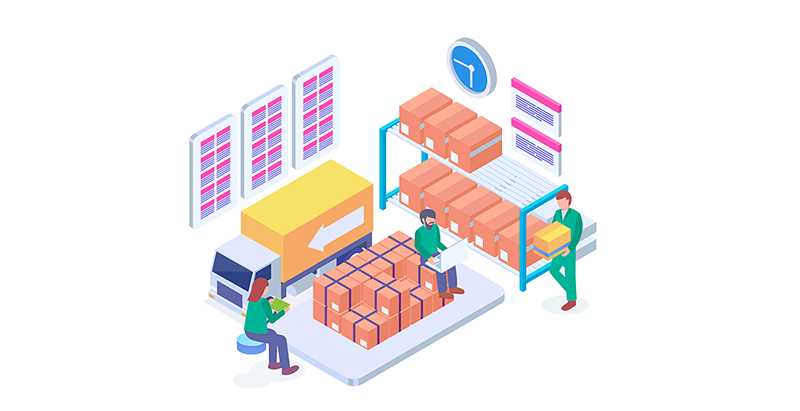When you are running a business, it’s vital to critically assess every investment that goes into it. Whether it's calculating the ROI of the printer in the office or that of your warehouse management system. While doing the former is straightforward, the latter, not so much.
In this article, we’ll answer some of the burning questions about figuring out the ROI of your WMS; Is it possible to measure WMS ROI, why and how you should do it, and more.
An investment is deemed an investment only through its returns.
- Lamine Pearlheart
Is It Possible to Measure the ROI of a WMS?
Let's cut to the chase. It is absolutely possible to measure the ROI of your WMS. However, it is a convoluted process as the returns of a WMS extend beyond monetary benefits. These are the three types of ROI a WMS delivers:
1. Tangible ROI
Tangible ROI refers to the returns you can quantify. You can just measure these by looking at the pre-WMS and post-WMS figures. Some examples of tangible ROI are a decrease in labor costs, an increase in order picking accuracy, an increase in volume picked per person, etc. Simply put, Tangible ROI means measuring the KPIs.
2. Intangible ROI
Intangible ROI is not apparent as it’s not quantifiable. However, you reap these benefits in other forms that contribute to the entire warehouse’s efficiency. Some examples of intangible ROI are employee satisfaction, better collaboration between workers, easy access to data, inventory transparency, etc.
3. Support ROI
When your WMS helps you get new opportunities or lets you do a specific thing in a better way and opens new sources of revenue then this ROI is called support ROI. This is probably the most difficult of the lot to measure as these benefits are evident only in the long term.
For instance, when your WMS has a specific feature that fulfills a client requirement, or it fulfills a futuristic regulatory need. These allow you to cater to new markets or provide better value to your existing customers.
Benefits of Measuring the ROI of Your WMS
A WMS offers an array of benefits, some accurately measurable, some silently improving efficiency. Correlating these benefits with the cost of the technology helps you make informed decisions while upgrading. These are some of the other benefits of calculating the ROI:
- You can calculate when you break even the cost of acquiring the technology.
- You can identify how exactly your WMS solved a problem.
- You can determine the under-utilized functionalities of your WMS.
- You can pinpoint the areas that need improvement, so you can upgrade the technology.
- You can tweak how you manage various practices in the warehouse to get better results.
- You can get a better understanding of your clients and their requirements.
How to Measure the ROI of Your WMS?
Calculating the ROI of your WMS in simple terms is comparing the investment made on acquiring the technology to the profit obtained from using the technology. To make this comparison, first, estimate the costs and the returns.
Step 1: Determine the Costs
Unlike the office printer that comes with a price tag, the pricing of a WMS is not straightforward; there are several hidden costs that you don't anticipate initially. However, you can avoid these surprises by thoroughly discussing your warehouse needs with your WMS vendor.
You can even request demos, mockup invoices, or a detailed breakup of the costs. This way, you can compare different WMS considering the price, features, and long-term benefits. While a cheap WMS can help you save a couple of thousand bucks a year, an expensive one can benefit your more in the long run.
The above tips will help your estimate the costs if you are still searching for a WMS. But if you already have one, you can simply look at the previous invoices.
Step 2: Estimate the Returns
In alignment with what we have already discussed in the previous sections, a warehouse management system’s returns come in all forms, so the task here is to estimate their intrinsic value. Some of the major intangible returns are:
1. Space Utilization
As huge as your warehouse may look, it won't be able to hold an endless number of goods. This is where a WMS helps you by optimizing space usage. This consequently reduces rentals, avoids overstocks, and minimizes supply chain delays which indirectly saves money.
2. Inventory and Equipment Management
Inventory is the lifeblood of any warehouse; failure to manage inventory can quickly affect your entire business. A WMS triggers POs and chooses appropriate picking practices like LIFO, FIFO, FEFO, etc.
These automatically help you avoid stockouts, keep track of product expiration times, and maintain healthy inventory levels. WMS also helps streamline how you use your equipment. This will increase their longevity and reduce maintenance and service costs.
3. Customer Satisfaction and Employee Morale
When your warehouse is managed well without supply chain delays and stockouts, your customers are happy, making them come back to your again. Similarly, improved visibility lets workers access and use information in a better way. This will decrease their workload and improves efficiency.
Step 3: Analyze the ROI
Once you have all the estimates ready, all you need to do is compare the costs against the gains. While this entire process seems complicated, it will help you understand how your warehouse management system is making you profits. When used efficiently, a WMS pays itself off via its KPIs.
Measure WMS ROI to Identify Potential Areas of Improvement
As the scale of warehouses, the complexity of the operations, and the diversity of the goods stored are evolving, a WMS helps manage all of these efficiently. Calculating the ROI of your WMS can extend its benefits as it helps you find places where you can make better use of it. Even though the process is a bit tricky, not skipping this step can help you expedite your business’s profits.








